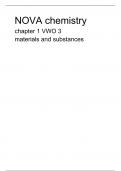Summary
Summary NOVA chemistry chapter 1 VWO 3 materials and substances
- Course
- Level
This summary is about chapter 1 of NOVA chemistry. The chapter is called materials and substances and that is also reflected in it. It's really the basics you need to know for chemistry. That is why it can also be useful to buy and review this song if you are already past chapter 1 but have not und...
[Show more]



